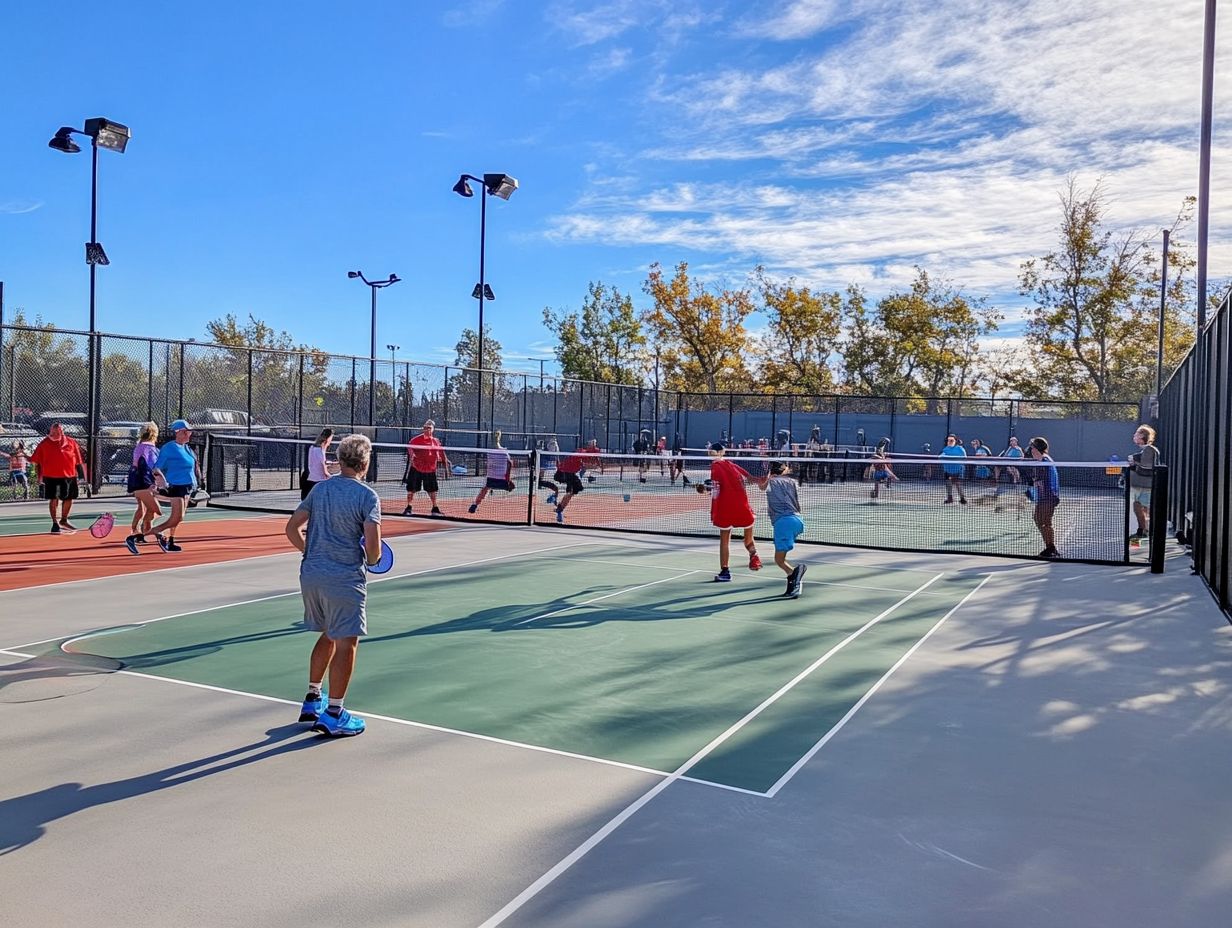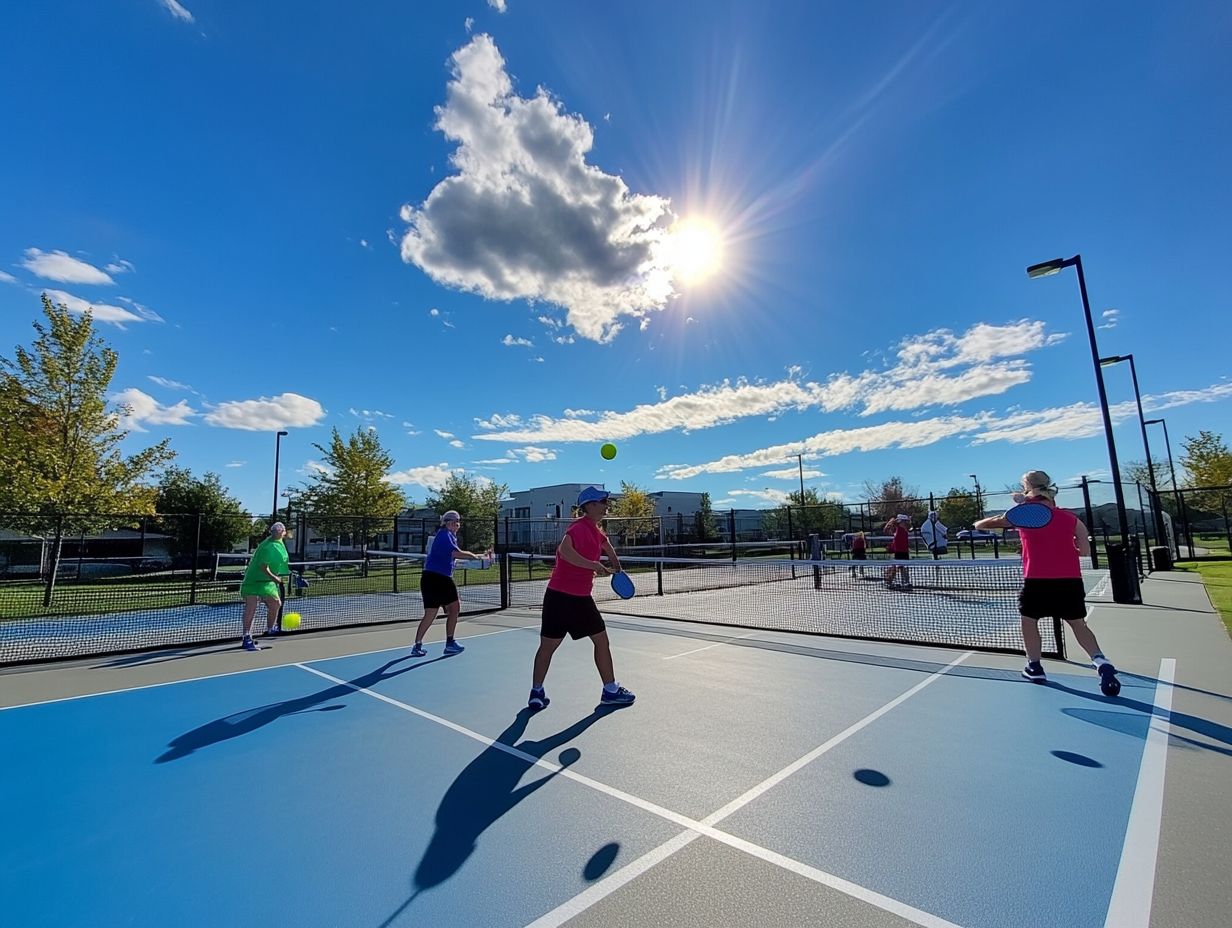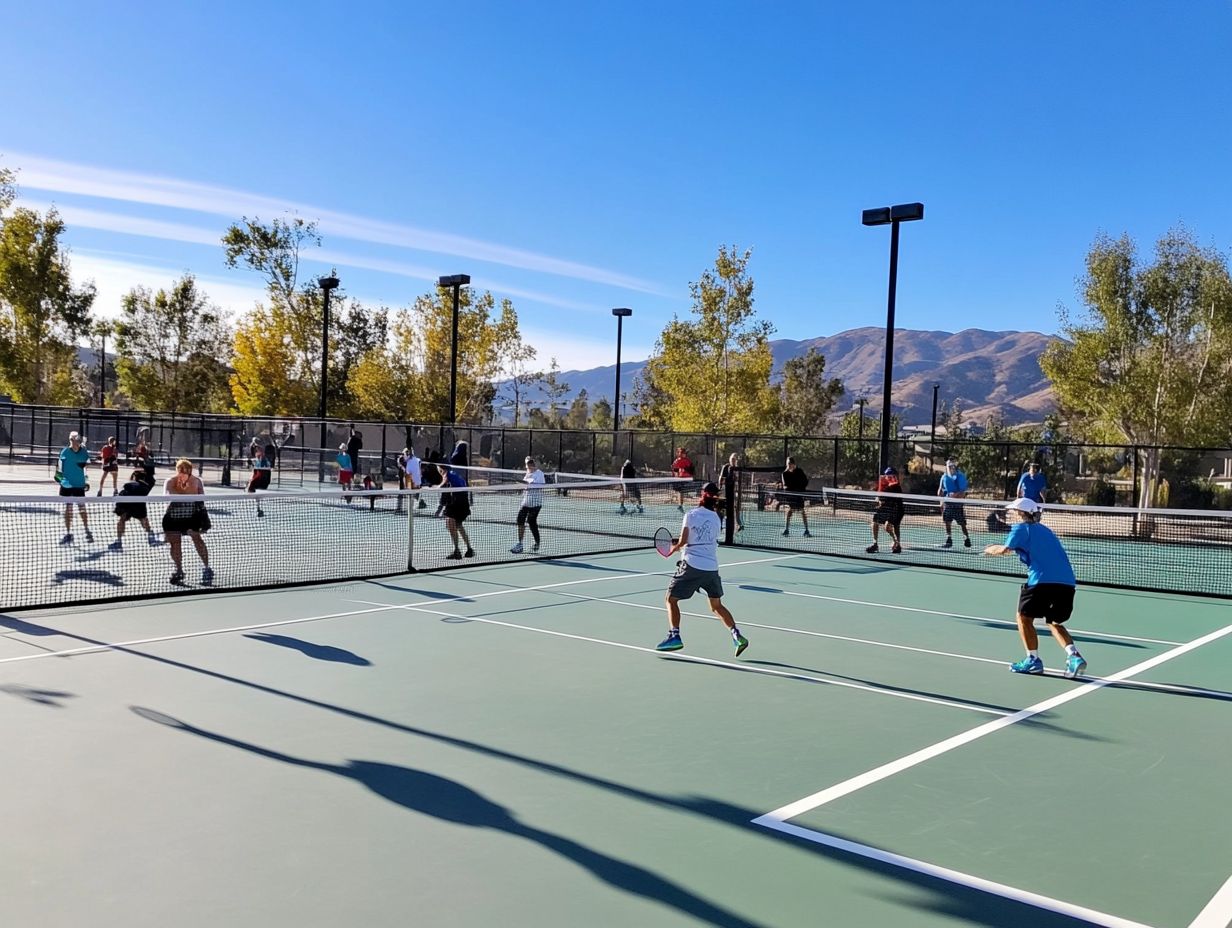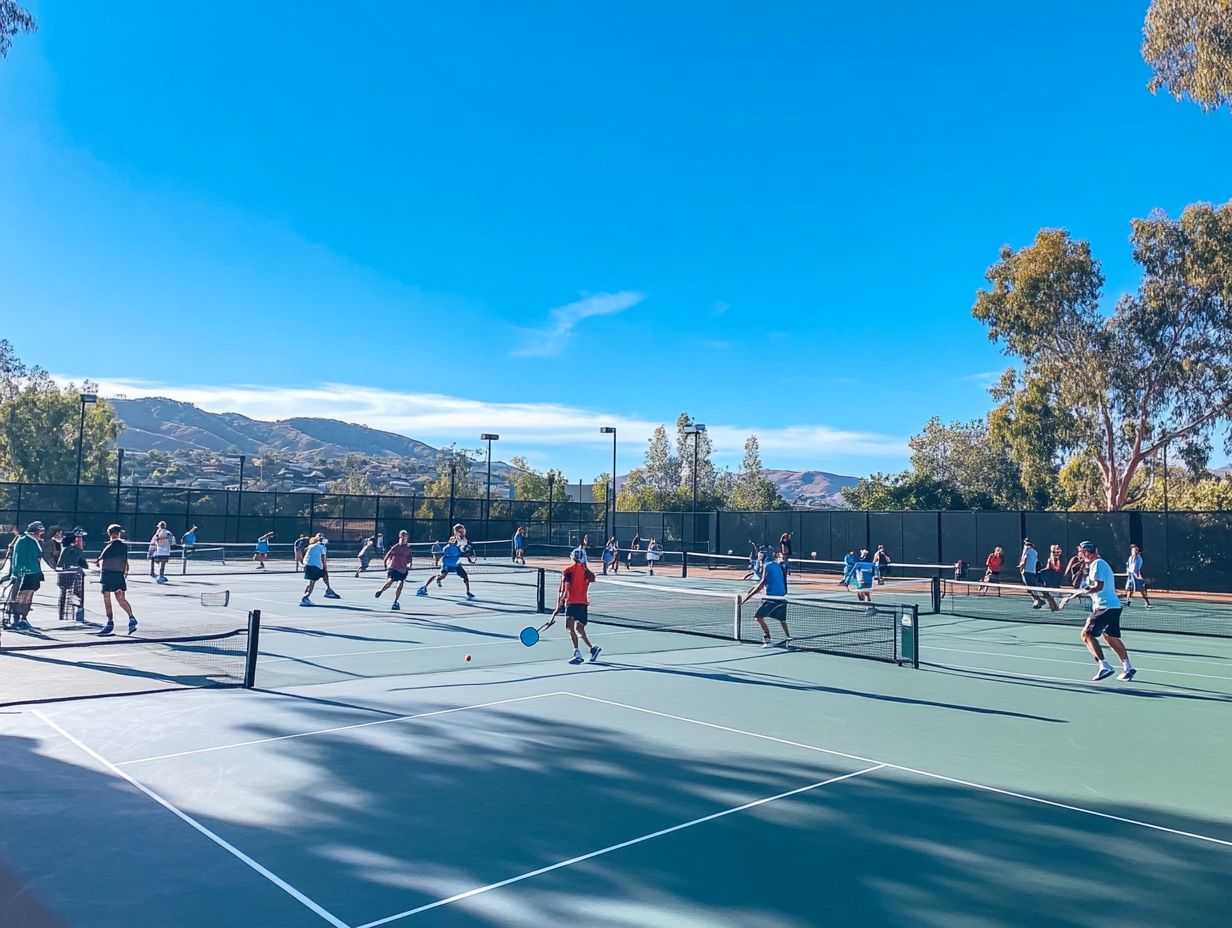Pickleball is a rapidly growing racket sport that combines elements of tennis, badminton, and table tennis. Played on a court with specific dimensions, it can be enjoyed both indoors and outdoors. The game utilizes a paddle and a plastic ball with holes, making it suitable for players of all ages and skill levels. Invented in the mid-1960s, pickleball has evolved into a popular recreational and competitive sport, often featuring tournaments and a strong community.

Origins: Pickleball was created in 1965 by three fathers—Joel Pritchard, Bill Bell, and Barney McCallum—on Bainbridge Island, Washington, USA. The game was designed to entertain their children during the summer, using improvised ping-pong paddles and a perforated plastic ball.
Goals: The objective of the game is to serve the ball over the net and score points when the opposing side fails to return the ball according to the rules.
Size & Dimensions: A standard pickleball court measures 20 feet wide and 44 feet long, similar in size to a doubles badminton court. The center of the net stands at 34 inches high.
Equipment: To play pickleball, the only necessary equipment includes a paddle, a lightweight plastic ball with holes, and proper footwear suitable for the court surface.
Players: Pickleball can be played with either two or four players, following a scoring and serving format akin to tennis. It is suitable for individuals of all ages and skill levels, and is often played recreationally in community centers or clubs. Many local pickleball communities and clubs organize tournaments.
Pickleball Timeline:
- 1965: Pickleball is invented in Washington, USA.
- 1972: The non-profit USA Pickleball Association (USAPA) is founded to promote and develop the game in the United States.
- 2005: The International Federation of Pickleball (IFP) is established to promote the sport internationally.
- 2010: The US Center for Sports Safety publishes guidelines for safe pickleball play.
- 2019: Pickleball is introduced at the Pan American Games for the first time.
- 2020: Pickleball is named the fastest-growing sport in the US by the Sports & Fitness Industry Association (SFIA) according to their 2020 Participation Report.
- 2022: By this year, pickleball had become the fastest-growing sport in the world, played in over 50 countries.
Pickleball Rules: The game is played on a rectangular court measuring 20 feet wide and 44 feet long, with the USA Pickleball Association recommending a minimum court size of 30 feet wide by 60 feet long. For international tournaments, the International Federation of Pickleball allows courts to measure 36 by 64 feet. The net height is 34 inches in the center and 36 inches at the sides, similar to a tennis net. The non-volley zone, also known as the kitchen, extends 7 feet from the net, and there are two service boxes on either side of the centerline, each measuring 10 feet wide and 15 feet long.
The game is played using rectangular paddles made from solid materials such as wood or composites. The lightweight plastic ball, which typically weighs 0.8 ounces (22.7 grams) and measures 2.87 inches (7.3 cm) in diameter, features holes that reduce wind resistance, allowing for play indoors and outdoors. Indoor pickleballs have 26 holes, while outdoor ones have 40.
Rules of Playing Pickleball: The game can be played as either singles or doubles. In a doubles match, each team comprises two players, and every player on the serving team gets a turn to serve. If the serving team loses a rally, the serve passes to the opposing team, and the player who served first becomes the receiver. Games are typically played to a total of 11, 15, or 21 points, with a player or team needing to win by at least 2 points. Points can only be scored by the serving team, and the serve must land in the designated diagonal service box of the opposing team. If the serve touches the centerline, it is considered valid; however, if it touches the sideline, it is a fault.
When serving, the ball must be hit below the waist, and it must bounce before the return. The ball can only be returned after one bounce. The non-volley zone prevents players from standing too close to the net and spiking the ball.
Advantages of Playing Pickleball: A 2021 study conducted by researchers from the University of Notre Dame, titled “Pickleball as a Safe, Structured, and Multidisciplinary Approach to Community Engagement in Older Adults,” found that pickleball is a safe and structured sport that promotes community engagement among older adults. Its relatively low-impact nature and social aspect make it enjoyable for people of all ages, whether they play recreationally or competitively.
Why is it Gaining Popularity?
Pickleball is rapidly gaining popularity due to its accessibility, social nature, and numerous fitness benefits, making it an appealing choice for individuals of all age groups.
This beginner-friendly sport encourages physical activity and community engagement, serving as an excellent medium for social interaction and enjoyment among players. The game’s unique blend of elements from tennis, badminton, and ping pong allows for fast-paced play that enhances cardiovascular health while improving agility and coordination.
As a low-impact sport, pickleball can be enjoyed by senior adults aiming to stay active, as well as younger adults seeking a competitive outlet. The vibrant pickleball community fosters friendships and relationships, creating an ideal environment for those looking for support and camaraderie.
With the emergence of many local clubs and organized events, it is no surprise that the number of players attracted to the exhilarating sport of pickleball is on the rise, combining fitness and fellowship in an exciting setting.
The Basic Rules of Pickleball
The fundamental rules of pickleball encompass the scoring system, serving regulations, definitions of faults, gameplay mechanics, and the distinctions between playing doubles and singles. By understanding these basic rules, new players can successfully join the game, while experienced players can ensure that it is played correctly.
Court and Equipment Setup
The dimensions and proper setup of a pickleball court are crucial for an effective game. A standard pickleball court measures 20 feet wide and 44 feet long, regardless of whether it is used for singles or doubles play. The court features specific markings that define various areas where play occurs.
Players utilize a paddle and a perforated plastic ball to engage in the game. The court is divided into several zones, including the non-volley zone, commonly referred to as the “kitchen,” which extends 7 feet from the net on both sides. Each side also contains service courts, which are 10 feet deep and play an important role in serving.
Pickleball paddles are made from composite materials and come in a variety of weights and sizes to accommodate player preferences. The balls are designed for either indoor or outdoor play, depending on the environment, and feature holes that enhance aerodynamics.
Moreover, proper court markings, such as the baselines and sidelines, are essential for ensuring fair play and guiding players in their movements during this enjoyable sport.
Scoring System

The scoring system in pickleball is unique and has a significant impact on gameplay dynamics, as it utilizes a rally scoring format. In this system, points can be earned by either the serving or receiving team, which makes every rally crucial.
Games are typically played to 11 or 15 points, with a requirement of at least a two-point margin to win. As a result, players must maintain consistent focus on their performance throughout the match, since each point can shift the momentum in favor of one team or the other.
Service Rules
The service rules in pickleball provide the guidelines that dictate how and when players can serve the ball, ensuring that the game is played fairly. Proper adherence to these rules is essential to prevent faults, which can result in the loss of a serve or point.
The most critical service rules include the following:
- Players must serve underhand
- The ball must be struck below the server’s waist
- It must land in the diagonal service court
Understanding the specifics of serve placement—such as angle, depth, and spin—can significantly impact the outcome of each point. Players should practice various types of serves to regularly alter the angle and depth, thereby keeping their opponents guessing.
Additionally, players must work to avoid common service faults, such as stepping over the baseline before serving or failing to make the ball bounce in the proper service area. Mastering the rotation of service allows players to exploit the weaknesses of their opponents’ games, enhancing the overall strategy employed during matches.
Playing Strategies
Effective playing strategies are essential for success in pickleball, as they can significantly enhance performance and improve overall gameplay. Understanding player positioning and various gameplay tactics—such as lobbing, smashing, and utilizing drop shots—enables players to gain a competitive edge during matches.
Mastering these techniques is crucial for outmaneuvering opponents and controlling the pace of the game. Proper player positioning, for example, involves maintaining an optimal distance from the net and being prepared to respond to any shot. Strategic movement can help players exploit gaps in their opponents’ defense.
Additionally, combining aggressive plays with defensive strategies, such as anticipating your opponent’s shots, can further elevate one’s game. When players blend quick reflexes with well-timed placements, they create scoring opportunities while simultaneously applying pressure on their rivals.
Skills and Techniques for Beginners
Developing essential skills and techniques is crucial for beginners in pickleball to establish a strong foundation in the sport. Practice drills, training tips, and basic techniques will help new players enhance their skills and build confidence as they engage in the game.
Serving Techniques

While basic serving techniques in pickleball are crucial for beginners to build confidence and gain experience, learning advanced serving techniques is equally important. These advanced techniques enhance overall skills, introduce a tactical dimension to the game, and can provide a competitive edge over opponents.
Advanced serving techniques include various types of serves, such as the underhand serve, lob serve, and topspin serve, each offering distinct benefits and tactical applications that players should master. For instance, the underhand serve can catch opponents off guard, while the lob serve can push opponents back and alter the tempo of the game.
By learning these techniques, players can better manipulate their opponents’ positioning and reactions, leading to scoring opportunities. Additionally, mastering advanced serving techniques boosts a player’s confidence and enriches their overall skill set.
Consistent practice is essential, as it builds muscle memory and improves accuracy, making these serves invaluable tools for every player.
Forehand and Backhand Shots
Forehand and backhand shots are essential components of gameplay in pickleball, and mastering these techniques is crucial for success on the court. By practicing proper grip and stance, players can effectively execute these shots, thereby improving their overall accuracy and control.
Understanding the mechanics involved in forehand and backhand shots greatly enhances performance. For a forehand shot, a continental grip is often recommended, as it allows for flexibility in shot selection. Positioning oneself with feet shoulder-width apart while slightly bending the knees helps maintain balance and generate power.
In contrast, the backhand shot benefits from a grip that may involve wrapping the thumb around the paddle handle for greater stability. Players should orient themselves to face the side of the court, with their non-dominant foot forward, to pivot effectively.
Practicing drills that focus on these mechanics will enable beginners to build confidence and consistency in their shot-making abilities.
Volleys and Dinks
Volleys and dinks are two of the most important shot techniques in pickleball, as effectively utilizing them can significantly influence the way a game is played and ultimately determine the outcome of a match. Understanding when to use volleys and dinks, along with the proper techniques for executing them, gives players a competitive edge in controlling rallies and outsmarting their opponents.
A volley is a shot made in pickleball without allowing the ball to bounce on the court. This technique is most commonly used when a player is at the net, preparing to intercept an incoming ball. Since the ball is struck before it has the chance to bounce, volleys require quick reflexes and excellent hand-eye coordination. Players often employ volleys when they notice that their opponent is out of position, aiming to capitalize on the opportunity.
In contrast, a dink shot is a soft stroke that just clears the net and quickly drops on the opponent’s side. Dinks are strategically used during intense exchanges at the net or when players are positioned near the kitchen line. A well-placed dink can put the opposition in a difficult position for their return, disrupting their rhythm and shot selection.
Mastering both volleys and dinks allows a player to control the match’s tempo, making them essential techniques in any pickleball player’s repertoire.
Common Mistakes to Avoid
Common mistakes made by beginners in pickleball can hinder both their progress and enjoyment of the game. Novice players often fall into pitfalls such as foot faults, double hits, and hitting shots out of bounds. These errors can negate their hard work and provide opponents with easy points.
Foot Faults

Foot faults are a common mistake in pickleball that occur during the serve and have specific implications for the game’s rules. A foot fault occurs when a player steps over the baseline or into the non-volley zone before hitting the ball, resulting in the loss of the serve.
This violation not only disrupts the flow of the game but also serves as a reminder of the importance of accuracy and adherence to the established serving rules. By ensuring that their feet remain planted behind the baseline until the ball is struck, players can avoid committing an infraction that could grant their opponents a free point.
The significance of foot faults can also be leveraged to enhance a player’s strategy, as it emphasizes the critical nature of proper foot placement during serving; even a single misstep can alter the course of the game.
Double Hits
Double hits are commonly encountered in pickleball and can confuse new players, often resulting in faults and the loss of points. A double hit occurs when the ball strikes the paddle twice during a single stroke, which is against the rules of the game.
This violation can happen in various scenarios, such as when players attempt to execute a quick volley or when the paddle inadvertently brushes the ball on the follow-through. It is important for players to understand that even if they believe they have made clean contact, a double hit will still be called if the ball touches the paddle more than once.
This rule is crucial for maintaining the integrity of the game, as it encourages skillful ball control and clean shots. Learning to avoid double hits not only helps players avoid penalties but also enhances their overall gameplay and strategy.
Out of Bounds Shots
Out-of-bounds shots in pickleball can disrupt gameplay and negatively affect a player’s score; therefore, understanding the court markings is essential to avoid hitting the ball out of bounds. Any shots that land outside the designated court area are automatically considered faults, resulting in a point for the opposing team.
Recognizing court boundaries is crucial for maintaining an effective strategy and enhancing overall performance in the game. Players should familiarize themselves with the specific court lines, including the baseline, sidelines, and no-volley zone, to better gauge their position and the ball’s trajectory.
By paying close attention to these boundaries, players can significantly reduce the likelihood of making careless mistakes that lead to out-of-bounds shots. Developing court awareness not only improves a player’s skill set but also contributes to a more enjoyable experience for everyone involved in the match.
Tips for Navigating Pickleball Etiquette
An explanation of pickleball etiquette highlights its significance in fostering a positive environment and ensuring enjoyable play for all participants. It emphasizes the role of sportsmanship and communication in maintaining proper etiquette, as well as the importance of respecting others within the sport’s culture.
Courtesy and Communication
Communication and courtesy are essential elements of pickleball that enhance the overall experience for all players involved. Examples of effective communication and courteous behavior in pickleball include:
- Calling out the score
- Complimenting good plays made by the opposing team
- Engaging in friendly banter
These actions foster camaraderie and sportsmanship among competitors. For instance, acknowledging a great shot by an opponent with a compliment contributes to a positive atmosphere for everyone.
Additional examples of courtesy include:
- Keeping the court tidy by returning balls after rallies
- Refraining from interfering with others’ games
Players should also communicate clearly when serving or receiving to avoid confusion and potential issues. By practicing these forms of etiquette, players not only enhance their own experience but also create an inviting environment that encourages others to continue playing and enjoying the game.
Respecting Opponents
Respecting opponents in pickleball is crucial for fostering a healthy competitive spirit and enhancing the experience for everyone involved. Acknowledging the skills and efforts of fellow players goes beyond mere sportsmanship; it contributes to a positive and encouraging environment.
Respect for opponents can be demonstrated in various ways, such as offering sincere compliments after a well-played point or promptly returning the ball after a fault. Maintaining control of emotions, even in challenging situations, is vital for promoting etiquette on the court.
Players should also recognize the significance of shaking hands or offering words of encouragement before and after matches, as these gestures play a key role in promoting camaraderie and showing mutual respect.
By engaging in such actions, players contribute to creating a welcoming atmosphere that allows everyone to enjoy and feel included in the game.

Pickleball’s more than a game to me—it’s a passion. I write, sharing its highs and lows, the thrills and the lessons. Some tales might draw you to the court, while others give a hint of the game’s magic. So, curious about my journey? Ready to dive deep into the world of pickleball with me? Let’s go.
